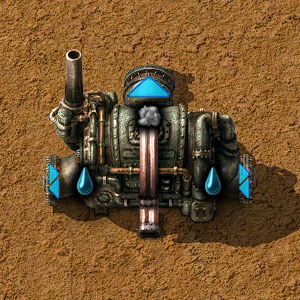Heat exchanger: Difference between revisions
(Removed usage tips. Restored old explanations. Removed excessive comments. Merged heat capacity back into first section.) |
m (Heat exchangers convert 10MJ/s heat to steam, not steam engines.) |
||
| Line 8: | Line 8: | ||
== Calculating steam production rate == | == Calculating steam production rate == | ||
Heat exchangers produce 103 steam/second.This can be calculated by relying on [[steam turbine]] data: A steam turbine consumes 60 steam/second and produces 5.82MW (assuming 500°C steam). This means a single unit of 500°C steam has <code>5.8MW / 60/s = 0.097 MJ</code> of energy. A | Heat exchangers produce 103 steam/second.This can be calculated by relying on [[steam turbine]] data: A steam turbine consumes 60 steam/second and produces 5.82MW (assuming 500°C steam). This means a single unit of 500°C steam has <code>5.8MW / 60/s = 0.097 MJ</code> of energy. A heat exchanger produces 10 MJ a second, therefore it produces <code>10MJ / 0.097MJ = 103.0927835 </code> steam per second. | ||
The steam production rate can also be calculated using the energy consumption: 1 Heat exchanger consumes 10MW, so it's putting 10,000,000 joule of energy into heating water/steam per second. To heat up 1 unit of water 1 degree, 200 joules are needed, so the heat exchanger is heating up water by 50,000°C in total. But the water only gets heated up from 15°C to 500°C, so by 485°C. So the 50,000°C are enough to heat up 103 units of steam per second, since <code>50,000 / 485 = 103.09</code>. | The steam production rate can also be calculated using the energy consumption: 1 Heat exchanger consumes 10MW, so it's putting 10,000,000 joule of energy into heating water/steam per second. To heat up 1 unit of water 1 degree, 200 joules are needed, so the heat exchanger is heating up water by 50,000°C in total. But the water only gets heated up from 15°C to 500°C, so by 485°C. So the 50,000°C are enough to heat up 103 units of steam per second, since <code>50,000 / 485 = 103.09</code>. | ||
Revision as of 01:33, 5 October 2018
| Heat exchanger |
|
Recipe |
|
| + + + → | |
|
Total raw |
|
| + + + |
|
Recipe |
|
| + + + → | |
|
Total raw |
|
| + + + |
|
Map color |
|
|
Fluid storage volume |
Input: 200 |
|
Health |
200 |
|
Resistances |
Explosion: 0/30% |
|
Stack size |
50 |
|
Dimensions |
2×3 |
|
Energy consumption |
10 MW |
|
Maximum temperature |
1000 °C |
|
Mining time |
0.1 |
|
Prototype type |
|
|
Internal name |
heat-exchanger |
|
Required technologies |
|
|
Produced by |
|
The heat exchanger exchanges heat between a heat connection and water to produce steam.
Heat exchangers produce ~103 steam with a temperature of 500°C every second.
Heat exchangers will not produce steam until they reach 500°C. The steam produced is exactly 500°C hot, even if the exchanger is hotter. Heat exchangers have a heat capacity of 1 MJ/°C. Thus, they can buffer 500 MJ of heat energy across their working range of 500°C to 1000°C, and require 485 MJ of energy to warm up from 15°C to 500°C when initially placed.
Calculating steam production rate
Heat exchangers produce 103 steam/second.This can be calculated by relying on steam turbine data: A steam turbine consumes 60 steam/second and produces 5.82MW (assuming 500°C steam). This means a single unit of 500°C steam has 5.8MW / 60/s = 0.097 MJ of energy. A heat exchanger produces 10 MJ a second, therefore it produces 10MJ / 0.097MJ = 103.0927835 steam per second.
The steam production rate can also be calculated using the energy consumption: 1 Heat exchanger consumes 10MW, so it's putting 10,000,000 joule of energy into heating water/steam per second. To heat up 1 unit of water 1 degree, 200 joules are needed, so the heat exchanger is heating up water by 50,000°C in total. But the water only gets heated up from 15°C to 500°C, so by 485°C. So the 50,000°C are enough to heat up 103 units of steam per second, since 50,000 / 485 = 103.09.
History
- 0.15.0:
- Introduced
- Doubled the heat capacity of water from 0.1kJ per degree per liter to 0.2kJ
